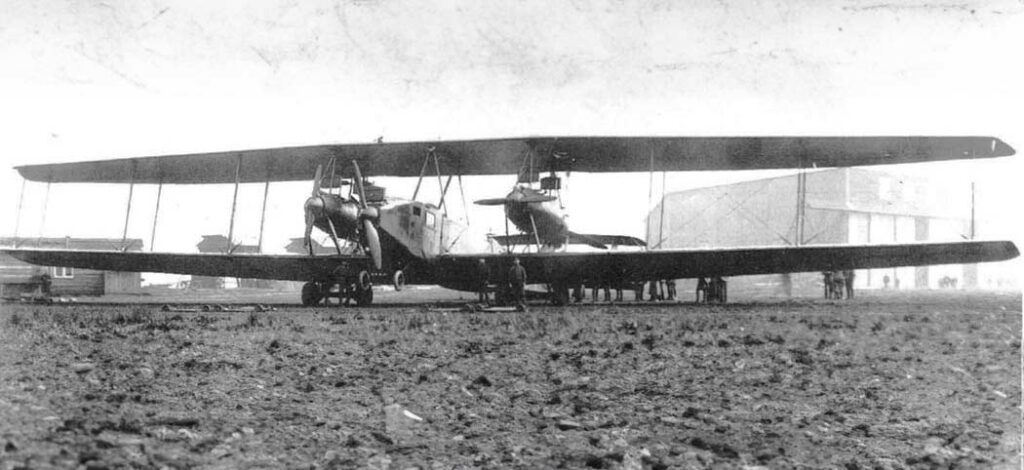The Zeppelin-Staaken R.XIV, a WWI German heavy bomber, represented the pinnacle of strategic bombing capability for its time. The Zeppelin-Staaken R.XIV was a colossal aircraft designed for strategic bombing during World War I. It featured multiple engines and was one of the largest aircraft to participate in the conflict. This article delves into the history of its development, design intricacies, performance parameters, military role, and operational history.
During World War I, the concept of strategic bombing emerged, focusing on targeting infrastructure and industrial capabilities of an enemy. The Zeppelin-Staaken R.XIV was developed by Germany to fulfill this new military doctrine, aiming to deliver substantial payloads over long distances.
History of the Development of the Zeppelin-Staaken R.XIV
World War I saw a rapid evolution in military technology, with air power becoming a strategic factor. Germany, which had pioneered the use of lighter-than-air Zeppelins for bombing, found them increasingly vulnerable to improved enemy defenses. The solution was the creation of heavier-than-air bombers capable of carrying comparable payloads to the Zeppelins but with better speed and a lower operational altitude to evade anti-aircraft fire.
The Zeppelin-Staaken R.XIV was the result of this shift in strategy. Developed by the aviation branch of the Zeppelin company, Staaken, the R.XIV was part of a series of “Riesenflugzeuge” (giant aircraft) designed to fulfill the role of strategic bombers. These aircraft were to strike distant targets such as London and Paris to undermine the morale and industrial capacity of the enemy.
Launched by Staaken, the R.XIV program began amid the war, leveraging the experience gained from earlier R-series aircraft. The development aimed to surpass the limitations of the predecessors, with increased payload and range. The R.XIV first took to the skies in 1917, a demonstration of Germany’s industrial and technological might.
Design of the Zeppelin-Staaken R.XIV
The Zeppelin-Staaken R.XIV was a marvel of engineering, with an impressive wingspan of 42.2 meters (138 feet 5 inches) and a length of 22.1 meters (72 feet 6 inches). It was powered by multiple engines—usually four or six—arranged in tandem configurations, pushing and pulling to provide the necessary thrust.
Constructed primarily of wood and fabric, the R.XIV featured a biplane design, with two sets of wings to support the heavy airframe. Its design allowed for a substantial bomb load but resulted in a relatively slow and lumbering aircraft. The multi-engine configuration was a significant advancement, but synchronization and maintenance were complex and time-consuming.

Performance of the Zeppelin-Staaken R.XIV
Equipped with four or six 260 hp Mercedes D.IVa engines, the R.XIV had a maximum speed of around 135 km/h (84 mph), a service ceiling of approximately 4,000 meters (13,123 feet), and could carry a bomb load of up to 1,000 kg (2,200 lbs). With a range of 800 km (497 miles), it could reach distant targets while evading some ground-based defenses.
Compared to its contemporaries, the R.XIV was not particularly fast or agile. However, its size and payload capacity were unmatched by most other aircraft of the time, except for other R-series giants.
Military Use and Combat of the Zeppelin-Staaken R.XIV
The R.XIV carried a defensive armament that included several 7.92 mm Parabellum MG14 machine guns positioned in the nose, midsection, and tail for protection against enemy fighters. Its use in combat was limited due to its late entry into the war and the small number produced. The primary role was strategic bombing, targeting cities and infrastructure, attempting to bypass the static trench warfare on the ground.
The R.XIV’s main competitors were not other aircraft but anti-aircraft defenses and the ever-improving fighter aircraft of the Allies. After the war, the Treaty of Versailles restricted Germany’s ability to produce such bombers, leading to the end of the R.XIV program.
The aircraft did not see post-war service and was not exported to other countries. It was ultimately replaced by smaller, more efficient bombers as air warfare evolved.
The Zeppelin-Staaken R.XIV stands as a testament to the ambition and innovation of wartime aviation design. Its development marked the zenith of Germany’s quest for aerial supremacy through strategic bombing during WWI. Although it saw limited use, the R.XIV contributed to the foundational concepts of strategic air power that would be expanded upon in the decades following the war.
Back to the Bombers section.